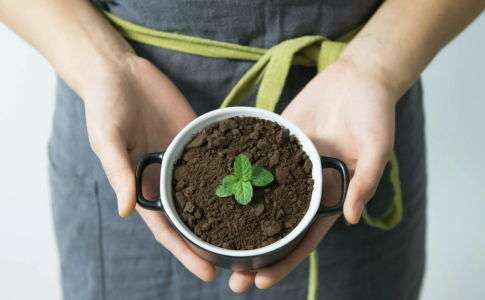Don’t throw away those coffee grounds—your garden might need them
By
Veronica E.
- Replies 0
For many of us, the day doesn’t truly begin until that first cup of coffee.
But what happens to the grounds once the pot is empty?
Too often, they end up in the trash, when they could be put to far better use.
Gardeners have long known that certain plants respond especially well to coffee grounds, turning kitchen waste into natural fertilizer.
If you’re curious about which plants benefit most and how to use this simple trick, here’s what you should know.

Coffee grounds are full of nutrients like nitrogen, potassium, and magnesium—minerals that enrich the soil and encourage growth.
They also improve drainage, help retain moisture, and can attract earthworms that naturally aerate the soil.
On top of that, reusing grounds keeps them out of the landfill, making it a small but meaningful way to reduce household waste.
Not every plant will thrive with coffee, but these groups are known to benefit:
Some plants don’t respond well to coffee grounds.
Geraniums and asparagus ferns may be harmed by the added acidity.
Overuse can also create a crust on the soil surface that prevents water from soaking in.
When in doubt, add grounds to compost first instead of applying directly.
If you’re in a warm climate like Florida’s Space Coast, this is an important month for planting and preparation:
Next time you brew your morning coffee, consider giving those grounds a second life in the garden—they may be exactly what your plants have been waiting for.
Read next:

Do you already use coffee grounds in your garden? Have you noticed a difference in your plants—or do you have another creative gardening hack to share? Share your experiences in the comments, and you might inspire another GrayVine reader to try something new.
But what happens to the grounds once the pot is empty?
Too often, they end up in the trash, when they could be put to far better use.
Gardeners have long known that certain plants respond especially well to coffee grounds, turning kitchen waste into natural fertilizer.
If you’re curious about which plants benefit most and how to use this simple trick, here’s what you should know.

Coffee grounds can be repurposed as a natural boost for certain plants, turning everyday waste into garden gold. Image Source: Pexels / Cats Coming.
Why coffee grounds belong in your garden
Coffee grounds are full of nutrients like nitrogen, potassium, and magnesium—minerals that enrich the soil and encourage growth.
They also improve drainage, help retain moisture, and can attract earthworms that naturally aerate the soil.
On top of that, reusing grounds keeps them out of the landfill, making it a small but meaningful way to reduce household waste.
Three types of plants that love coffee grounds
Not every plant will thrive with coffee, but these groups are known to benefit:
1. Acid-loving plants
- Examples: Blueberries, azaleas, rhododendrons, hydrangeas, camellias, gardenias, and roses.
- Why they love it: Coffee grounds lower soil pH slightly, giving these plants the conditions they need for bigger blooms and healthy foliage.
2. Vegetable garden staples
- Examples: Carrots, radishes, potatoes, strawberries, kale, spinach, and leafy greens.
- Why they love it: The nitrogen in coffee grounds supports steady, leafy growth. Lightly mixing them into soil or compost provides a natural boost.
3. Indoor houseplants
- Examples: African violets, peace lilies, pothos, Christmas cactus, and philodendrons.
- Why they love it: A pinch of grounds mixed into potting soil can help keep these plants green and healthy. Just be sure to use sparingly, since too much acidity can harm them.
Also read: A common gardening tool may be more dangerous than you think
How to use coffee grounds
- Add to compost: Coffee counts as a “green” material—balance it with “browns” like dry leaves or shredded paper.
- Apply directly: A thin sprinkle (less than half an inch) around plant bases works well for acid-loving varieties.
- Mix with mulch: Grounds can be blended into mulch to retain moisture and limit weeds.
- Supercharge soil: Mixing grounds with biochar creates a nutrient-dense soil booster.
Also read: Don’t throw out your chocolate boxes—gardeners are loving this surprising trick!
A few cautions
Some plants don’t respond well to coffee grounds.
Geraniums and asparagus ferns may be harmed by the added acidity.
Overuse can also create a crust on the soil surface that prevents water from soaking in.
When in doubt, add grounds to compost first instead of applying directly.
Also read: Are you overwatering without realizing it? These 4 expert tips can help your plants thrive
Seasonal gardening tips for September
If you’re in a warm climate like Florida’s Space Coast, this is an important month for planting and preparation:
- Prune poinsettias for the last time before the holidays.
- Plant herbs such as chives, thyme, mint, rosemary, and oregano.
- Sow fall vegetables like arugula, beans, broccoli, kale, carrots, and spinach.
- Observe fertilizer bans: Some counties restrict nitrogen and phosphorus until October—opt for organic solutions in the meantime.
Also read: Toxic beauty: 14 flowers and plants to be cautious about
Money-saving and space-smart tricks
- Dollar store seeds: Stock up on budget-friendly packs.
- Vertical planters: Perfect for small yards or balconies.
- Pest management: Grow marigolds, lavender, or chives to divert pests from vegetables.
- Weed safely: Tools like Grampa’s Weeder let you pull weeds without bending.
- Soil enhancers: Earthworm castings or mycorrhizal fungi can give new plantings a stronger start.
Next time you brew your morning coffee, consider giving those grounds a second life in the garden—they may be exactly what your plants have been waiting for.
Read next:
- Do your supermarket plants always die? Here’s what experts want you to know
- These signs will tell you if your plants are begging for more sunlight!
- Don’t let your garden dry out while you’re on vacation—here’s how to keep it thriving while you’re away
Key Takeaways
- Coffee grounds are rich in nitrogen, potassium, and magnesium, making them useful for enriching soil and benefiting acid-loving plants, vegetables, and certain houseplants.
- Not all plants thrive with coffee—geraniums and asparagus ferns may be harmed, and overuse can create overly acidic soil.
- September is an ideal month for planting herbs and fall vegetables in warm climates, along with final poinsettia pruning before the holidays.
- Gardeners can save money and space with hacks like dollar store seeds, vertical planters, natural pest control, and soil boosters like earthworm castings.
Do you already use coffee grounds in your garden? Have you noticed a difference in your plants—or do you have another creative gardening hack to share? Share your experiences in the comments, and you might inspire another GrayVine reader to try something new.






